Support Us
Since 1979 more than 140,000 animals have been treated by Wildlife Rescue.
Thanks to the support of individuals like you, Wildlife Rescue can provide a lifeline for animals in distress.
As avian influenza has been a hot topic over the past couple of months, we have received many questions from concerned wildlife enthusiasts about the virus. In this article, we address your questions and provide resources to stay up to date on avian influenza developments. For further information on avian influenza you can also refer to this article.
This avian influenza dashboard shows test results from across Canada.
In general, the risk to human health from wild birds infected with an avian influenza virus (both low and high pathogenic strains) is considered to be low. You can read more here.
However, since research regarding avian influenza is ongoing, it’s important to adhere to government guidelines, such as the recommendation to not handle sick wild birds.
You can find more government information and guidelines here.
The government recommends not to touch or handle sick birds or animals. Avian influenza is a respiratory disease. If you touch a sick bird or animal, then touch your eyes, nose, mouth or face, it is possible for you to get sick.
If you do touch a sick bird or animal, always wash your hands with soap and water and after removing gloves. Clean, disinfect or dispose of any potentially contaminated clothing, equipment or surface.
If you have touched or handled a sick or dead animal, watch for symptoms for 10 days after exposure. You can find additional guidance from the BC Centre of Disease Control here.
Currently, the Canadian government states: “There is no evidence to suggest that eating cooked poultry or eggs could transmit the virus to humans.” You can read more here.
Avian influenza, primarily adapted to birds, is not as easily transmitted to mammals. While much less common, many types of mammals have been infected including pigs, horses, dogs, domestic and wild cats, foxes, cows, goats, squirrels, mice, skunks, marine mammals, bears, mustelids, opossums and humans.
If your pet has been in contact with a sick bird, it’s important to monitor for symptoms. Fever, lethargy, eye infections, lack of appetite, difficulty breathing, or neurological issues (like seizures or tremors) are symptoms of avian influenza to look out for in dogs and cats.
If your pet is showing symptoms of avian influenza, contact your veterinarian immediately. If you do not have a vet, you can find the closest one to you here.
You can find additional information on how to protect your pet from avian influenza here.
Using a dedicated tub or laundry room sink may be wise to prevent splatter of any pathogens from bird feeders onto food preparation surfaces. Whether you clean your feeders in a sink, tub, or outside, we advise thoroughly disinfecting the area where you clean any feeders when you’re done. You can find additional feeder cleaning guidelines here.
When disinfecting any items it’s important to wear the necessary PPE, like gloves and a mask. Clean the contaminated area with soap and water and then disinfect the space and cleaning items.
Wash your hands with warm soapy water after removing your gloves. Be sure to dispose of the PPE and other contaminated items in a plastic bag.
Avian influenza is most prevalent in waterfowl and shorebirds, as well as any bird that scavenges or preys upon these birds i.e. birds of prey, gulls and corvids. However, other species may also become ill with avian flu.
Thus far, we are unaware of any reports of hummingbirds being affected by the avian influenza virus in Canada. If you’d like to stay updated about the species impacted by avian influenza, this government dashboard provides an up-to-date overview. Cornell Lab also shares a detailed list of affected species.
More commonly observed diseases among hummingbirds include fungal infections like candidiasis. This fungal infection causes a hummingbird’s tongue to swell, making it impossible for them to eat. As with other avian diseases, the spread of candidiasis can be prevented by cleaning feeders regularly.
You can find a detailed hummingbird feeder cleaning guidance here.
As the crisp air of fall sets in, many of us enjoy the vibrant colors and the cooler temperatures. However, for our feathered friends embarking on their journey south, this season poses significant risks.
Fall migration has started and the Wildlife Hospital has already seen a steep increase in birds admitted for window strike treatment in August and September. This uptick highlights the dangers migrating birds face as they navigate urban landscapes.
During migration, birds often travel at night and may be disoriented by city lights and reflective surfaces. Glass windows and railings, which can appear invisible to birds, present a deadly hazard. With their large windows and glass balcony railings, high-rise buildings are especially dangerous for migrating birds.

Window collisions are a leading cause of death for migratory and resident birds across the world. The stark reality is that these bird-glass collisions result in the death of approximately 25 million birds annually in Canada, a statistic reported by Global Bird Rescue.
Birds that have impacted a window often suffer from concussions, internal injuries, eye injuries, and fractured bones. Even if a bird seems to recover from an initial window strike, injuries can develop or worsen up to 48 hours later. This delayed effect makes immediate care from a trained wildlife rehabilitator critical for the survival of these birds.
There are several proactive measures you can take to help reduce window strikes and safeguard migrating birds:

If you encounter a bird that has collided with a window, it is important to seek help from a trained wildlife rehabilitator immediately. Contact the Wildlife Rescue Support Centre for assistance at wildliferescue.ca/report-an-emergency.
This year, Wildlife Rescue celebrates its 45th anniversary, marking decades of dedicated care thanks to the support of our incredible Wildlife Community. Your generosity today will support our vital work and help window strike victims recover. You can donate here.
By taking these steps, we can all contribute to creating a safer environment for our migrating avian neighbours. Let’s work together to ensure that every bird has a safe journey this fall!
In recent years, Wildlife Rescue has seen a noticeable change in the behaviour of wildlife species and reasons for admission to the Wildlife Hospital. Fluctuations in weather patterns, especially when it comes to extreme weather events like heat and fire weather, can result in wildlife having heat exhaustion, severe dehydration, birds leaving overheated nest boxes and rooftop nests prematurely, negative human-wildlife interactions, and increased rates of migration exhaustion.
For many birds and other wildlife species, heat waves can pose a significant risk of heat exhaustion and severe dehydration.
Each summer, Wildlife Rescue receives more and more reports of heat-impacted wildlife, including young gulls leaving their rooftop nesting areas prematurely to bats ejecting from overheated colonies. These patients are often found on the ground with the following symptoms:

One of the most recent overheated cases involved a bat who had tragically been found passed away and stuck to the pavement during a heat wave event. Another case involved a family of three Glaucous-winged Gull chicks who were found trapped in a metal gutter pipe who had all suffered major heat exhaustion. In all heat-related cases, dehydration is a major concern for the animal.
With increasingly hotter spring and summer seasons, some bird nestlings are prematurely jumping from their nest boxes to escape the intense heat, which can lead to severe injuries, dehydration, and exposure to predators at an age when they are defenseless.
Fledgling birds, who spend time on the ground before they are fully flighted, may wander too far from their parents in search of shade and water, which can result in them becoming orphaned.
As urban development in the Lower Mainland rises, wildlife habitats continue to diminish. Forests and green areas that provide birds and other animals with shade, shelter, and foraging grounds are becoming more challenging for wildlife to find, pushing them to move further into urbanized settings, and increasing their risk of anthropogenic problems.
The displacement of this crucial environment creates more human-wildlife conflicts through window strikes, pet attacks, vehicle collisions, and unintentional human-wildlife encounters.
Similarly, wildfires can destroy habitats and push animals into urban areas where they face these new, life-threatening dangers as well as heightened competition around food sources and shelter.
Heatwaves and wildfires can also disrupt migrating bird routes, leading to severe migration exhaustion. The hotter spring seasons can also lead to earlier migrations and nesting seasons, which can subsequently create further difficulties for affected animals. Wildfires can also force animals to deter from their usual migration routes pushing them into unfamiliar areas that can cause them more harm, especially in urbanized areas.
In February 2024, Wildlife Rescue received a report of a gosling, a youngster we would normally not see until late March to early April. In fact, December 2023 was tied for one of the warmest on record in BC.
During intense heat, it’s important to stay vigilant in helping protect our wildlife neighbours. Ensuring that you are regularly cleaning any bird feeders or baths is key to helping prevent the spread of diseases birds can easily pick up during temperature changes.
Another way you can help wildlife through extreme heat events is by leaving out bird baths, planting native shrubs and plants in your yard, or by propping household items up to create shade, like a cardboard box.
For more detailed information, you can find many other ways to help wildlife during extreme heat events here.
It is also important to not intervene with birds unless necessary. If you are concerned for a bird or bat’s health and safety, please contact Wildlife Rescue here.
Your garden can help wildlife! One way to make a significant difference for local wildlife is by allowing your yard to become a corridor of quality habitat while preparing for spring. Being intentional with your gardening can help the wildlife in your area thrive.
Keep an eye out for nesting birds when you are working on trees or undergrowth, as they are not always easy to spot!
In the Lower Mainland, the nesting period for most songbirds is between March 1 and August 31. Different species have different nesting behaviours and timing may be dependent on temperature or specific food availability.
Unless the tree is presenting a safety issue, the best practice is to schedule maintenance between September 1 to February 28 as to not disturb nesting wildlife. Some species, like hummingbirds, nest as early as December. It is always best to observe the tree beforehand, watching and listening for nest activity.
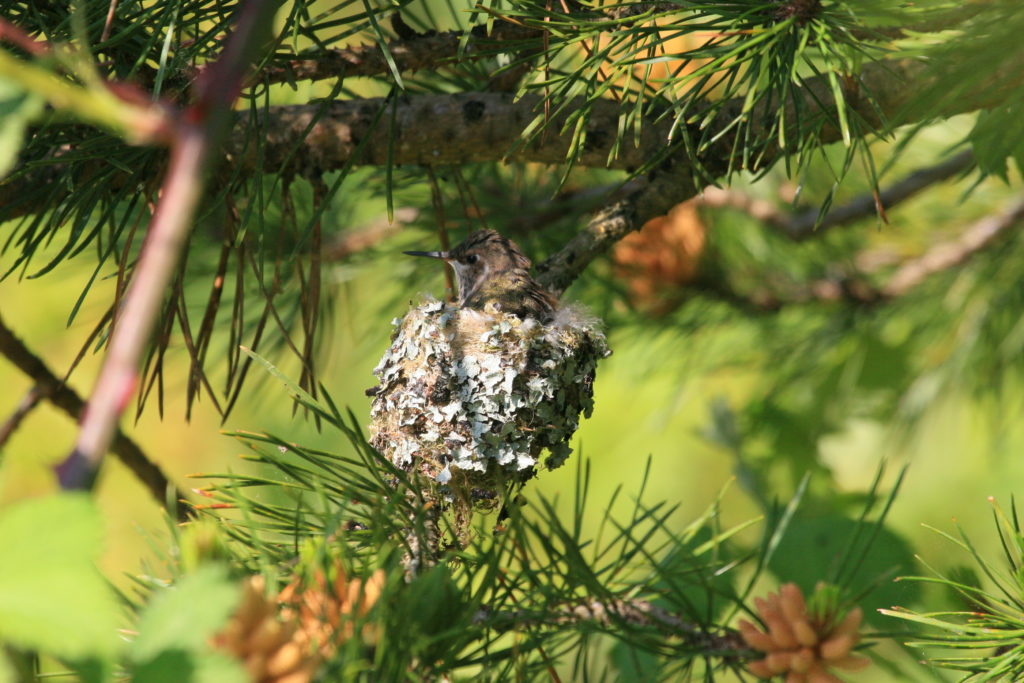
As the weather is getting warmer, we know that you are likely getting ready to prepare your garden for springtime, but we encourage you to keep any fallen leaves where they are. Leaves provide an important source of food and nesting material for wildlife, and refuge for overwintering pollinators like bees and butterflies.
If you must get rid of your leaves, wait until temperatures are consistently 10 degrees Celsius or higher before cleaning up. This will give these beneficial insects time to wake up for spring.
You can support wildlife by replacing your lawn with plants! This way your greenspace can support their foraging and provide them with shelter.
When it’s time to start planting, try opting for native plants for your yard or balcony. These species help feed hummingbirds and berry eaters. As an added bonus, you’ll attract all kinds of wildlife visitors to your yard without needing to maintain a feeder!
These are some of the native species you can plant in BC:
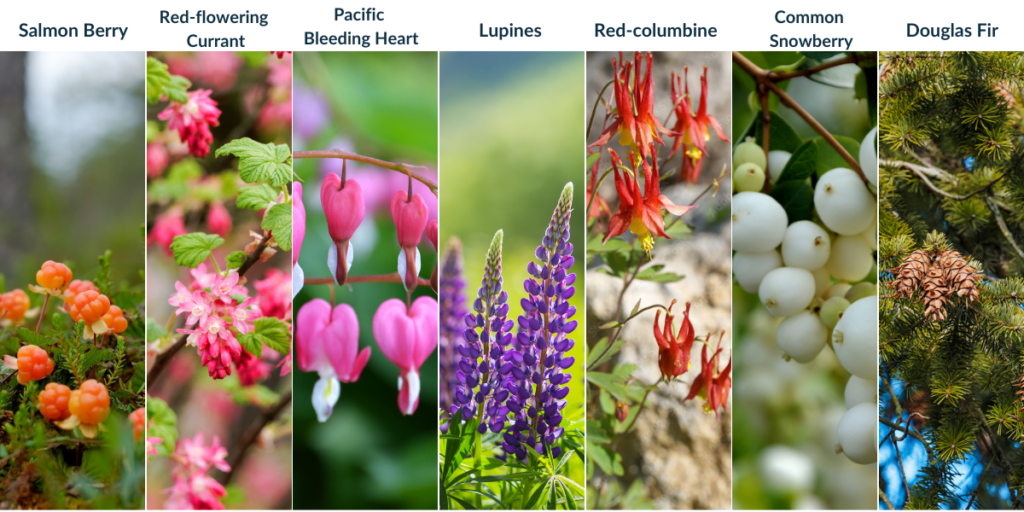
While the intended purpose of pesticides is to control pests, insects and weeds, these chemicals can be very harmful to wildlife.
Even though pesticides are often used only in specific areas such as lawns or gardens, rain can cause these chemicals to leach into local streams and rivers. This can kill invertebrates, and fish, which birds and other wildlife rely on as sources of food. These pesticides can sicken wildlife who ingest contaminated water and food, or absorb the poisons in the water through their skin. Rodenticides can harm, and even kill, raptors and mammals who eat poisoned rats and mice.
These are some recommended pesticide alternatives:
Gardening steps you can take to help prevent the need for pesticides:
All bird species have different nesting requirements. To become a successful bird house builder, see what each species requires here. Some of them can be picky!
You can create a bat roosting habitat by building a bat-house. To have it be successful in supporting bats, it’s important to do it correctly. You can find more guidance on bat houses here.
Avian influenza primarily affects domestic poultry and wild birds and is highly contagious amongst birds. Wild species most affected by avian influenza are ducks, geese, raptors and corvids (like crows and ravens). There is currently no treatment for the virus, and it can be very deadly to birds.
Wildlife Rescue notices an increase in birds presenting with contagious avian diseases, such as avian influenza, during fall and spring migration as birds naturally come together in large numbers.
Common symptoms of avian flu include:

For the most current guidance regarding wild birds, bird feeders, caring for domestic birds, and reporting sick or dead birds please visit the official Government of Canada website.
For a detailed overview, you can also refer to the BC Avian Infuenza Dashboard.
Wildlife Rescue is not responsible for the surveillance of avian influenza in Canada. For the most up-to-date reports and information on the status of avian influenza in Canada, please refer to the Government of Canada website.
UPDATE: While we understand it can be concerning to encounter sick wildlife in your community, there are various risks involved when handling wild animals. With protective measures for our staff, volunteers, and patients in place, Wildlife Rescue continues to accept sick animals. However, with recent developments regarding the Avian Influenza Virus (AIV), the federal government is advising the public not to handle sick wildlife at this time. You can find additional government guidance regarding AIV here.
Do not touch the bird before contacting Wildlife Rescue or the Interagency Wild Bird Mortality Line. They will give you PPE guidance depending on the situation at hand.
Some other things to keep in mind:
Found a deceased duck, swan, goose, raptor or three or more deceased birds together?
Contact the Interagency Wild Bird Mortality Line at 1-866-431-2473. The Interagency Wild Bird Mortality Line is a monitoring program that reports back to government agencies. You can find more information on the program here.
Found a live bird with avian flu symptoms?
Contact our Support Centre here:
At Wildlife Rescue, isolation drop-off spaces are in place to hold any patients suspected of carrying contagious diseases. We ask everyone bringing in sick animals to drop these off in the designated isolation drop-off space and follow the guidelines given to you by our Support Centre staff to help prevent disease from spreading.
If you decide to offer a hummingbird feeder, it’s essential for the birds’ safety to maintain it following the recommended guidelines all year round.
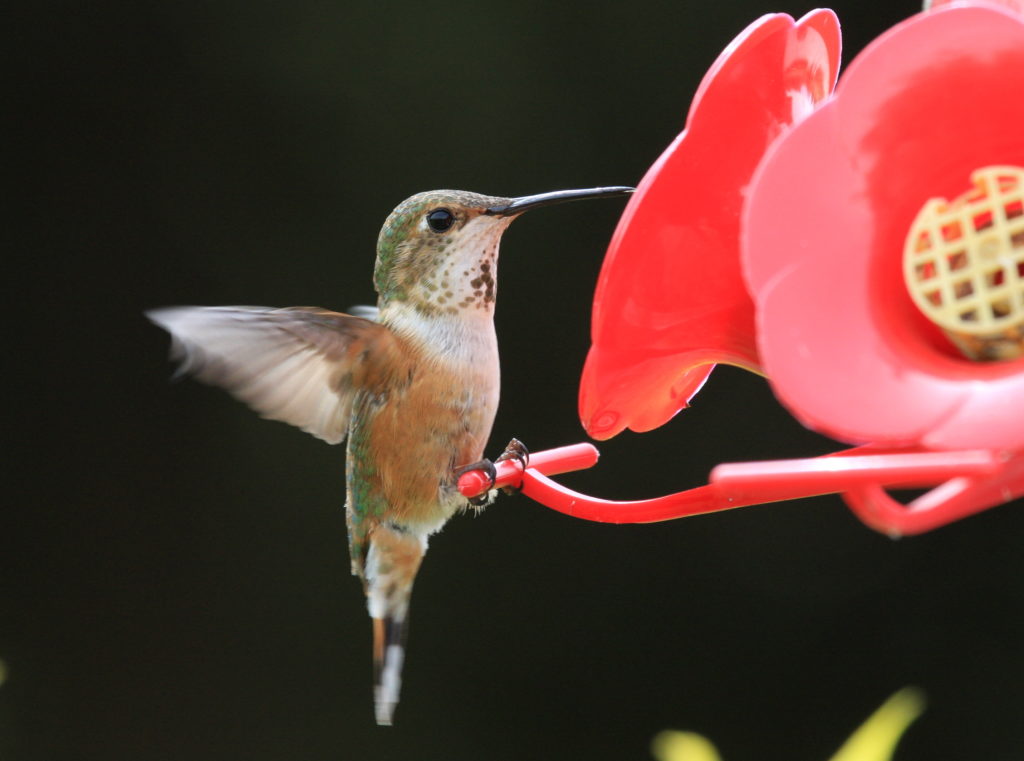
Hummingbirds have the highest metabolism of any warm-blooded animal. A high metabolism calls for high energy fuel. It’s no surprise these little birds love sugar! A simple mixture of refined, white table sugar dissolved in boiled water is sufficient for your hummingbird feeder.
Why pure white sugar?
You must ensure the sugar is pure white – a sign that the molasses has been removed. Molasses is high in iron and can be toxic to hummingbirds. Never use honey, brown sugar, icing sugar, juice, or artificial sweetener. Here’s why:
Sugar to water ratio guidance
The standard sugar to water ratio is 1:4. During frigid temperatures, some resources show you may be able to go as concentrated as 1:3 sugar to water ratio – never stronger. However, a fresh water source should also be provided at all times. When sharing information that is dynamic with conditions, we find that sometimes details can get lost along the way. Ultimately, we want to do no harm to our hummers. A 1:4 ratio of sugar to water is consistently safe to provide.
Never add red dye! Hummingbirds are attracted by the red colours of the feeder itself, not the nectar inside. Food colouring could potentially be harmful.
Feeders can cause deadly infections if not maintained properly as bacteria and fungi rapidly multiply. The recommended guidance on how to effectively clean your hummingbird feeder is as follows:

While all other species of hummingbirds that are found in BC (Rufous, Calliope, Black-chinned and Ruby-throated) seek out warmer climates during the cold winter months, Anna’s Hummingbirds have been living year-round in some areas of British Columbia since the 1990s.
Hummingbirds don’t hibernate in the traditional sense, but they often go into an energy-conservation mode called “torpor” when it gets cold in winter. Torpor is a deep sleep state in which an animal decreases its metabolic rate to consume less energy. In this state, a hummingbird’s heart rate can decrease from 1,260 beats per minute to fewer than 50 beats per minute. They also decrease their body temperature from 40°C to 18°C. Yet even during torpor, a hummingbird’s metabolism is so high, they will lose around 10% of their body weight overnight. To deal with the scarcity of nectar, hummingbirds tend to eat more insects over the winter.
Hummingbirds will feed heavily at dusk and then go into thick bushes, like cedar hedges or junipers to sleep. We recommend keeping feeders out until it gets dark and then rehanging a fresh, warm feeder at the first sign of light in the morning.
There are countless ways to keep a hummingbird feeder warm, such as a feeder heater, window feeder, hand-warmers, a wool sock, or even incandescent Christmas lights.
Whichever technique or setup you choose, please remember the following guidelines:
During cold snaps our Wildlife Hospital often sees an influx of hummingbirds with very low blood sugar and injuries related to frozen feeders.
Hummingbirds found on the ground need help. Other signs of distress include weakness, soiled feathers, tongue hanging out, and obvious injuries.
Contact our Support Centre here if you find a hummingbird displaying one or more of these signs.
Many of us like to give wildlife a helping hand by providing bird feeders over the cold fall and winter months. With various avian diseases spreading during these months, it is important to be mindful about offering food in a safe way. Ultimately, the goal is to do what is best for wildlife!
Wildlife Rescue notices an increase in birds presenting with contagious avian diseases, such as salmonella and conjunctivitis, during the colder months. Diseases can easily spread among birds sharing feeders because feeders attract large numbers of birds to one location.
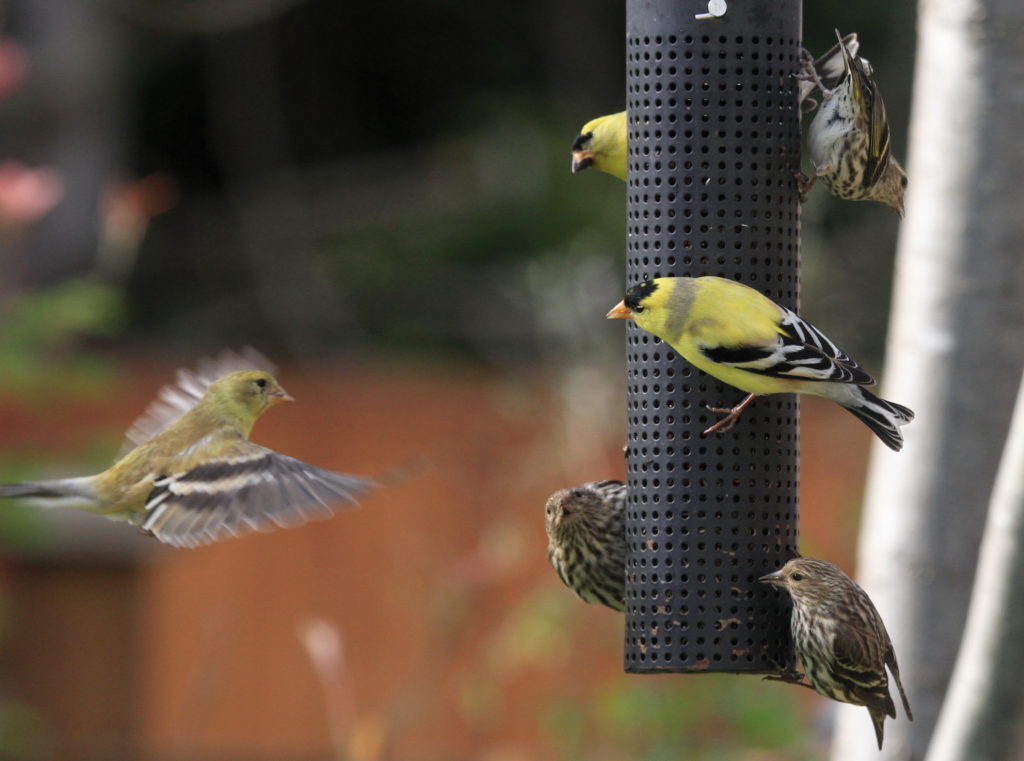
We can’t tell a sick bird not to come to the buffet, so sometimes it’s best just to postpone the dinner party before anyone else gets sick.
If you notice sick birds in your backyard, we recommend cleaning your feeders and putting them away for at least 3-4 weeks and until sick birds are no longer present in your backyard. This way you can help minimize the spread of avian diseases.
Here are a few symptoms to look out for:
If you are choosing to offer a feeder, we recommend taking the following steps to help keep wildlife safe:
Please note hummingbird feeders have a different set of recommendations.
Including native plants in backyard gardens is another effective way to provide food and shelter to wild birds over the fall and winter months. You will attract more wildlife visitors to your yard without needing to maintain a feeder.
These are some native species you can plant in BC:
Have you seen birds showing signs of disease, or do you have any questions? Reach out to our Support Centre for support and guidance here.
Thank you for looking out for your local wildlife!
Climate change is one of the biggest threats facing wildlife worldwide. It is happening twice as fast than the global average in Canada. Studies show that climate change leads to longer heat waves, stronger hurricanes, increased wildfire risk along with a longer wildfire season. It is predicted that there will be more droughts, heavier rain events and severe cold spells. The more gradual warming of our climate combined with these extreme weather events are endangering wildlife and the habitats they live in.
Mac Pearsall, assistant manager of Wildlife Rescue’s hospital says, “although heat waves and weather events have always happened, it is the severity and frequency that they are occurring at now that is the cause for concern.”
Here are some of the effects extreme weather events have on wildlife in BC.
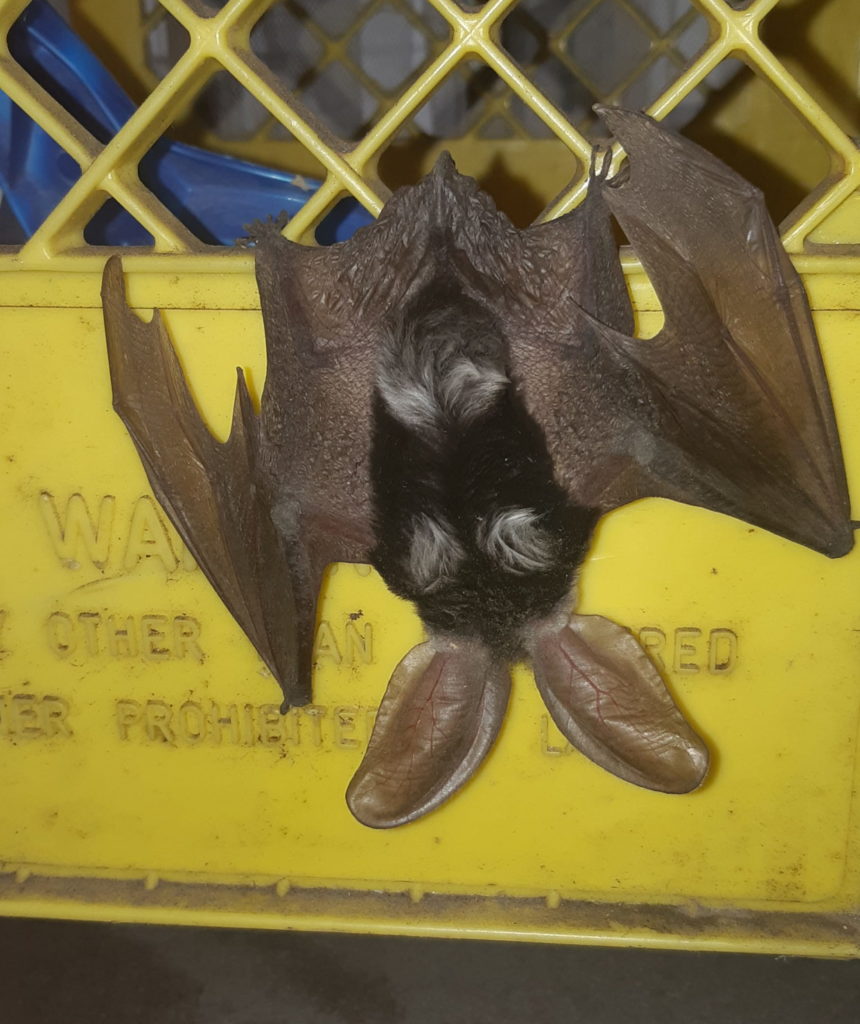
Extreme weather events are the most visible impact of climate change and at Wildlife Rescue we are seeing the impact on wildlife firsthand. In the fall of 2021, a Spotted Bat was rescued and brought into care at Wildlife Rescue. This rare bat, named for the three large spots across its shoulders was a unique visitor to the lower mainland. Spotted bats can typically be found in the dry interior valleys of British Columbia. The bat was dehydrated and underweight, after 19 days of care in our hospital it was successfully released. Climate change and extreme weather events may force wildlife like this spotted bat into new unfamiliar territories. Far from their regular habitat wildlife may have trouble finding the resources they need to survive, increasing the need for our organizations like Wildlife Rescue.
Contributed by Lauren Kerley, Wildlife Rescue Education Coordinator
Cute may not be the first word that comes to your mind when you see a baby bird. Hatchlings and nestlings can look strange, with odd proportions and unfamiliar plumage. Baby birds go through a huge transformation to become recognizable adult birds.
Swallow babies, like the Barn Swallow nestling pictured above, are great examples of a glow up in the bird world. Swallow babies undergo a beautiful transformation that prepares them for life on the wing.
Swallows are elegant birds both perched and in flight. Their distinct flight patterns, elongated body shape and deeply forked tail make them easily recognizable in flight. Their beautiful plumage is best admired while the birds are perched. Swallows have two tone plumage patterns, darker on top and lighter underneath. Colours range from glimmering cobalt blues found in Barn Swallows to vibrant greens and purples of the Violet-Green Swallows.
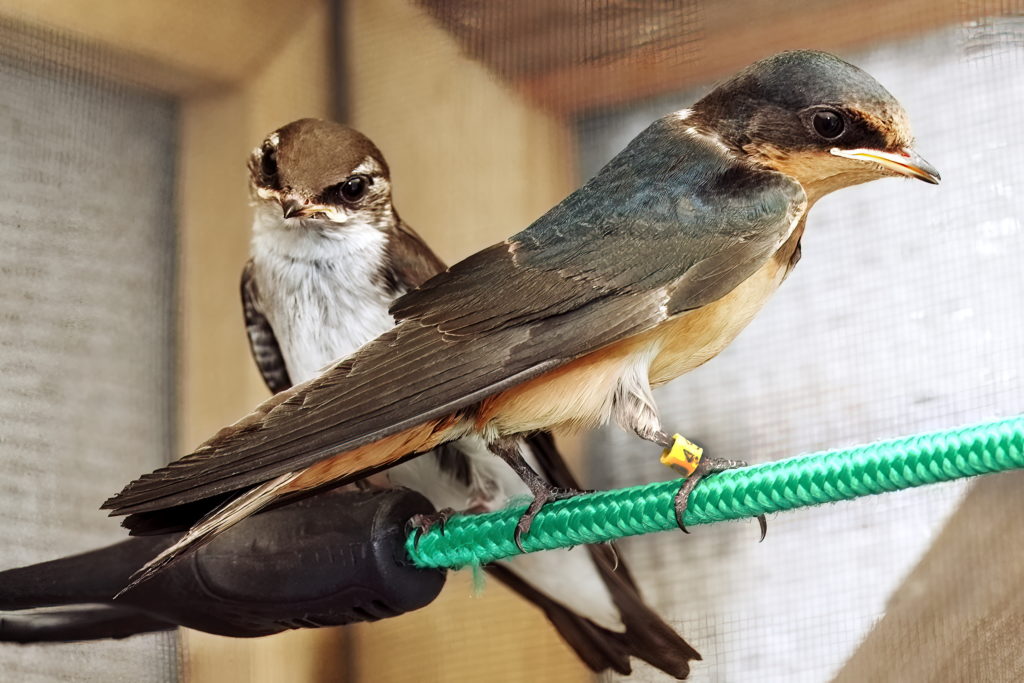
Their feathers are more than just for show though as the birds are highly specialized for aerial life, spending an impressive 60% of their time in the air. Not only do the birds hunt and eat in the air, but they also drink and bathe while in flight too!
Even these beautiful songbirds have drab babies, like many other baby birds, swallow nestlings have spotted or streaked plumage to help them camouflage in their nests, protecting them from predators. A lot of changes need to occur before babies are ready to leave the nest, a beautiful and necessary transformation.
Six swallow species call British Columbia home for at least part of the year; Bank Swallows, Tree Swallows, Cliff Swallows, Violet-Green Swallows, Barn Swallows, and Northern Rough-winged Swallows. Populations of all six swallow species are in decline, with Barn and Bank Swallows being designated as threatened species under COSEWIC (Committee on the Status of Endangered Wildlife in Canada).
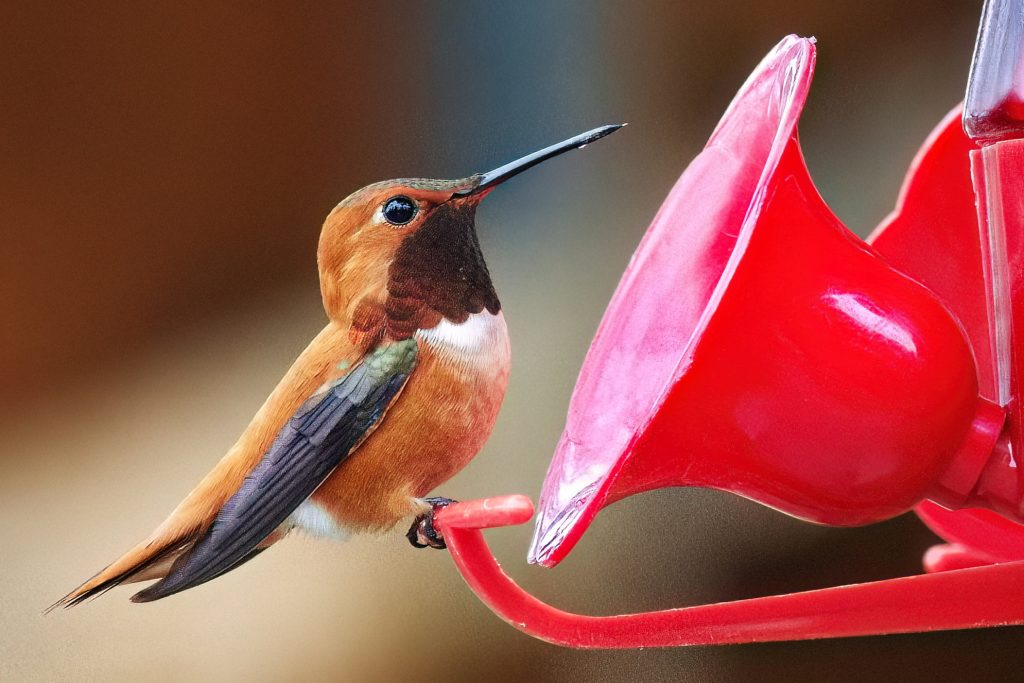
Hundreds of injured and orphaned wildlife patients arrive at Wildlife Rescue due to window and car strikes, nest disturbances, and natural and human disturbances.
Below is your step-by-step guide that takes you through the process of dropping off rescued animals.